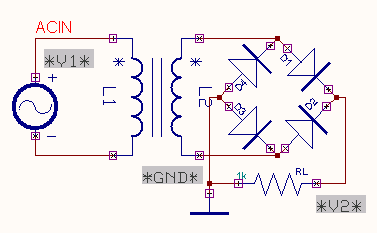Bridge Rectifier
Aim
To simulate a Bridge Rectifier circuit.
Components
|
Name
|
EDWin Components Used |
Description |
Number of components
required |
| TRANSFORMER |
TRANSFORMER |
Transformer |
1 |
| RES |
RC05 |
Resistor |
1 |
| DIODE |
1N4007 |
Diode |
4 |
| VGEN |
VGEN |
Ac voltage source |
1 |
| GND |
SPL0 |
Ground |
1 |
Theory
The Bridge rectifier is a circuit, which converts
an ac voltage to dc voltage using both half cycles of
the input ac voltage. The Bridge rectifier circuit is shown in the figure. The circuit has four diodes connected to
form a bridge. The ac input voltage is applied to the diagonally opposite
ends of the bridge. The load resistance is connected between the other two ends
of the bridge. For the positive half cycle of the
input ac voltage, diodes D1 and D3 conduct, whereas diodes D2 and D4
remain in the OFF state.
The conducting diodes will be
in series with the load resistance RL and hence the load current flows through
RL. For the negative half cycle of the input ac
voltage, diodes D2 and D4 conduct whereas, D1 and D3 remain OFF. The conducting diodes D2 a nd D4 will be in series with the load resistance RL and hence the current flows
through RL in the same direction as
in the previous half cycle. Thus a bi-directional wave is converted into a unidirectional wave.

Peak Inverse Voltage
Peak inverse voltage represents the maximum voltage that
the non- conducting diode must withstand. At the instance the secondary
voltage reaches its positive peak value, Vm the diodes D1
and D3 are conducting, where as D2 and D4 are reverse biased and are
non-conducting. The conducting diodes D1 and D3 have almost zero
resistance. Thus the entire voltage Vm appears across
the load resistor RL.
The reverse voltage across the non-conducting diodes D2 (D4) is also Vm. Thus for a Bridge rectifier the peak
inverse voltage is given by

Ripple Factor
The ripple factor for a Full Wave Rectifier is given by

The average voltage or the dc voltage available across the load
resistance is



RMS value of the voltage at the load resistance is


Efficiency
Efficiency, h is the ratio of the dc output
power to ac input power


The maximum efficiency of a Full Wave Rectifier is 81.2%.
Procedure
EDWinXP> Schematic Editor: The
circuit diagram is drawn by loading components from the library. Wiring and proper net
assignment has been made. The values are assigned for relevant components.

EDWinXP -> Mixed Mode Simulator: The
circuit is preprocessed. The test points and waveform markers are placed
in input and output of the circuit. GND net is set as reference net. The Transient Analysis
parameters have been set. The Transient Analysis is executed and output
waveform is observed in Waveform Viewer.
Result
The output waveform may be observed in the waveform viewer.
